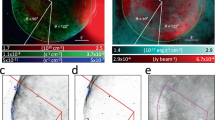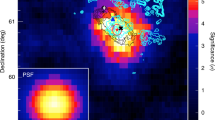Abstract
SUPERNOVAE explosions with total energies of 1049 to 1052 ergs constitute the most energetic single events in our galaxy1,2. Pulsars, which now appear to be rotating neutron stars formed in supernovae, contain similar amounts of energy3,4, and it is believed that a large portion of this energy goes into accelerating relativistic particles, producing cosmic rays3–5. The acceleration mechanism models fall into two general classes: the gradual transfer of rotational energy through electromagnetic channels to particles4,6, and the shock wave hypothesis where most of the cosmic rays are accelerated during the initial explosion as the outer layers of the star are blown out at relativistic speeds5,7. As a consequence of the shock wave acceleration mechanism Colgate has shown that a burst of photons of total energy 5 × 1047 ergs per decade should accompany the explosion. The time width of this pulse is a fraction of a microsecond at the maximum photon energy of few GeV and proportionally longer at lower energies8. An experiment designed to detect this type of pulse using the atmospheric fluorescence method has already achieved the sensitivity and operation time necessary to observe such pulses, with negative results as yet9.
This is a preview of subscription content, access via your institution
Access options
Subscribe to this journal
Receive 51 print issues and online access
$199.00 per year
only $3.90 per issue
Buy this article
- Purchase on SpringerLink
- Instant access to full article PDF
Prices may be subject to local taxes which are calculated during checkout
Similar content being viewed by others
References
Minkowski, R. L., Ann. Rev. Astron. and Astrophys., 2, 247 (1964).
Ginzburg, V. L., and Syrovatskii, S. I., The Origin of Cosmic Rays (Macmillan, New York, 1964).
Gold, T., Nature, 221, 25 (1969).
Ostriker, J. P., and Gunn, J. E., Astrophys. J., 157, 1395 (1969).
Colgate, S. A., and Johnson, H. J., Phys. Rev. Lett., 5, 235 (1960).
Goldreich, P., and Julian, W. H., Astrophys. J., 157, 869 (1969).
Colgate, S. A., and White, R. A., Astrophys. J., 143, 626 (1966).
Colgate, S. A., Canad. J. Phys., 46, 5476 (1968).
Ögelman, H., and Bertsch, D., Acta Phys. Acad. Sci. Hung., 29, Suppl. 1, OG-15 (1970).
Colgate, S. A., Acta Phys. Acad. Sci. Hung., 29, Suppl. 1, OG-5 (1970).
Greisen, K., Ann. Rev. Nucl. Sci., 10, 63 (1960).
Wdowczyk, J., in Proc. Intern. Conf. Cosmic Rays, 691 (London, 1965).
Author information
Authors and Affiliations
Rights and permissions
About this article
Cite this article
ÖGELMAN, H. Extensive Air Shower Arrays as Detectors of Prompt Gamma Rays from Supernovae Explosions. Nature 228, 1181 (1970). https://doi.org/10.1038/2281181a0
Received:
Issue date:
DOI: https://doi.org/10.1038/2281181a0



